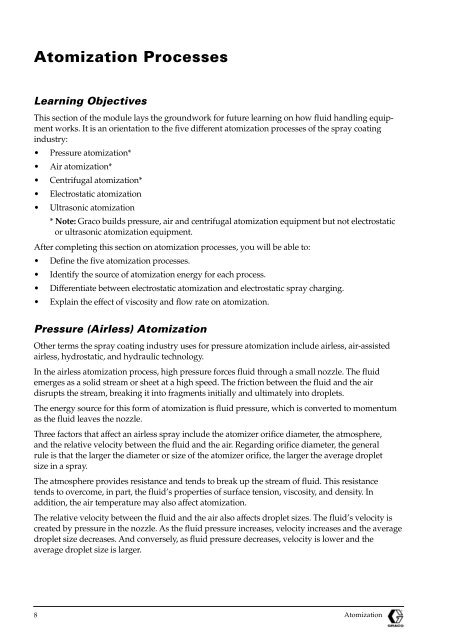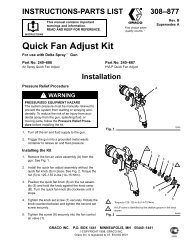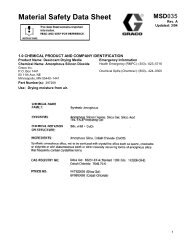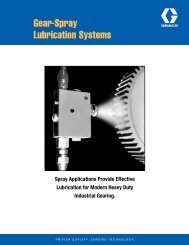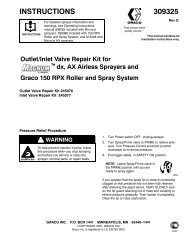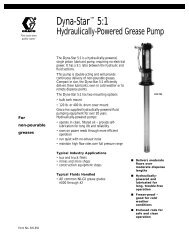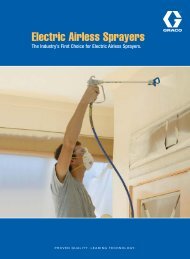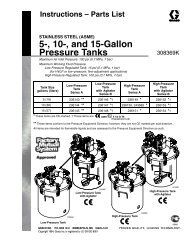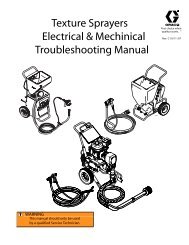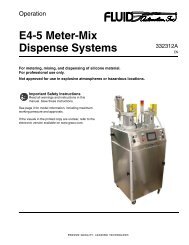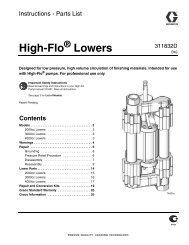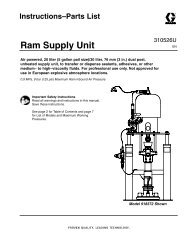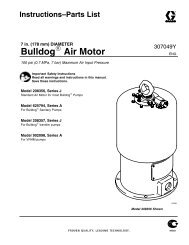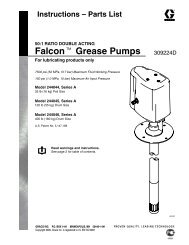Atomization - Graco Inc.
Atomization - Graco Inc.
Atomization - Graco Inc.
Create successful ePaper yourself
Turn your PDF publications into a flip-book with our unique Google optimized e-Paper software.
<strong>Atomization</strong> ProcessesLearning ObjectivesThis section of the module lays the groundwork for future learning on how fluid handling equipmentworks. It is an orientation to the five different atomization processes of the spray coatingindustry:• Pressure atomization*• Air atomization*• Centrifugal atomization*• Electrostatic atomization• Ultrasonic atomization* Note: <strong>Graco</strong> builds pressure, air and centrifugal atomization equipment but not electrostaticor ultrasonic atomization equipment.After completing this section on atomization processes, you will be able to:• Define the five atomization processes.• Identify the source of atomization energy for each process.• Differentiate between electrostatic atomization and electrostatic spray charging.• Explain the effect of viscosity and flow rate on atomization.Pressure (Airless) <strong>Atomization</strong>Other terms the spray coating industry uses for pressure atomization include airless, air-assistedairless, hydrostatic, and hydraulic technology.In the airless atomization process, high pressure forces fluid through a small nozzle. The fluidemerges as a solid stream or sheet at a high speed. The friction between the fluid and the airdisrupts the stream, breaking it into fragments initially and ultimately into droplets.The energy source for this form of atomization is fluid pressure, which is converted to momentumas the fluid leaves the nozzle.Three factors that affect an airless spray include the atomizer orifice diameter, the atmosphere,and the relative velocity between the fluid and the air. Regarding orifice diameter, the generalrule is that the larger the diameter or size of the atomizer orifice, the larger the average dropletsize in a spray.The atmosphere provides resistance and tends to break up the stream of fluid. This resistancetends to overcome, in part, the fluid’s properties of surface tension, viscosity, and density. Inaddition, the air temperature may also affect atomization.The relative velocity between the fluid and the air also affects droplet sizes. The fluid’s velocity iscreated by pressure in the nozzle. As the fluid pressure increases, velocity increases and the averagedroplet size decreases. And conversely, as fluid pressure decreases, velocity is lower and theaverage droplet size is larger.8<strong>Atomization</strong>®


